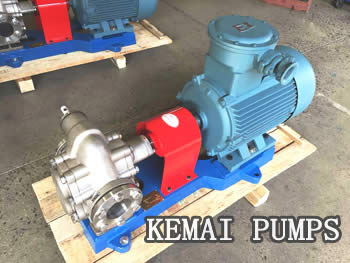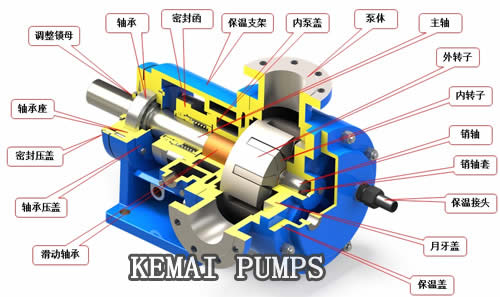Currently China’s popular stainless steel gear pump, pump material usually SS304 SS316 or SS316L
External stainless steel gear pump gears structure:

- Involute gears structure,The advantage is easier processing and lower prices,outlet pressure is 0.3~0.6MPA,flow range: 1.1~570M3/H.
- Arc gears structure, The advantage is low noise,outlet pressure is stable. outlet pressure is 0.6~1.6~2.5 MPA,flow range: 0.6~80M3/H.
Internal stainless steel gear pump gears:

- Gear pump structure mainly used to transfer high viscosity(10~100000cst)liquid,Example: resin, glue, polyurethane, etc.
- Flow range:0.6~200M3/H
- Head:less than 2.5MPA
SS Gear Pump Consists
Mainly consists of gear, shaft, pump body, safety valve, shaft end seal and other parts. After heat treatment, the gear has high hardness and strength, and is installed in the replaceable shaft sleeve to operate together with the shaft.The lubrication of all parts of the pump is achieved automatically when the pump works with the transmission medium.Stainless steel gear pumps in high sanitary conditions, such as medicine, food and other industries;In weak corrosive occasions, such as fine chemical, cosmetics, printing and dyeing, brewing industry.
KEMAI stainless steel gear pump performance
- Simple and compact structure, easy to use and maintain.
- Good self-absorption, so no liquid should be injected before each pump.
- Lubrication is achieved automatically by the conveying liquid, and lubricant is not required to be added when working.
- The small deviation caused by installation can be compensated by using elastic coupling to transfer power.
- When the pump is subjected to the inevitable hydraulic shock, it can play a good buffering role.
All of the above types of gear pumps all make of SS 304 316 316L, In addition, we can also make magnetic drive gear pump,Please tell us your name of liquid and viscosity, pump flow and head data,We will choose the right pumps for you.
Stainless steel gear pump SS 304 and SS 316L distinction:
Chemical composition distinction:
Today’s social building materials use stainless steel materials. In the early days, the application of stainless steel in construction was limited to some occasions. Architects are trying to find a new material with special effects without proper materials. In fact, in many of these cases, stainless steel has been used for a long time. The stainless steel material used in outdoor applications and even under the condition of high corrosive gas does not corrode. This has been confirmed by the long-term scouring of stainless steel. Get the trust of the manufacturer. The types and materials of stainless steel are various. Today, China Kemai pump will introduce the difference between stainless steel 304 and 316.
Performance distinction:
- 304 material composition is OCr18Ni9, 304 stainless steel C≤0.08 Ni8.00~10.00 Cr18.00~20.00, Mn<=2.0 Si<=1.0 S<=0.030 P<=0.035 316L is austenitic stainless steel, the material composition is OOCr12Mo2Ti,
- 316 stainless steel C≤0.08 Ni10.00~14.00 Cr16.00~18.00, Mo2.00—3.00 Mn<=2.0 Si<=1.0 S<=0.030 P<=0.035
- 316L stainless steel C≤0.03 Ni10.00~14.00 Cr16 .00~18.00, Mo2.00—3.00 Mn<=2.0 Si<=1.0 S<=0.030 P<=0.035 is a titanium-containing low carbon stainless steel, resistant to alkali and acid (except medium containing chloride ion). The big difference between 304 and 316 is that 316 is 2-3 nickel more than 304.
Different maintenance methods:
304 steel can resist corrosion of sulfuric acid, phosphoric acid, formic acid, urea, etc. It is suitable for general water use, and it is used to control gas, wine, milk, CIP cleaning liquid and other occasions with little or no contact with materials. The 316L steel grade has added molybdenum element on the basis of 304, which can significantly improve its resistance to intergranular corrosion, oxide stress corrosion and reduce the hot cracking tendency during welding, and it also has good resistance to chloride corrosion. Commonly used in pure water, distilled water, medicines, sauces, vinegar and other occasions with high hygiene requirements and strong media corrosion.
The price of 316L is almost double that of 304. Mechanical properties 304 is better than 316L. Because 304, 316 has excellent corrosion resistance and heat resistance, it is widely used as stainless steel. 304, 316 has similar strength and hardness. The difference between the two is that the corrosion resistance of 316 is much better than that of 304. The more important point is that molybdenum metal is added to 316, which has improved heat resistance.